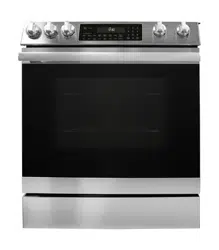Loading ...
Loading ...
Loading ...

E E E E E E E E E E E E E E E E E E
E E E E E E E E E E E E E E E E E E
E7
IMPORTANT SAFETY INSTRUCTIONS
COOKTOP SAFETY
WARNING
When using electrical appliances, take safety
precautions to reduce the risk of burns, electric shock, re,
injury to persons or property damage, including the following:
1 Use proper pan size. This cooktop has surface burners of
varied sizes. Select utensils with at bottoms large enough
to cover the surface burner's heating element.
Undersized utensils expose a portion of heating element to
direct contact and may result in risk of burns or ignition of
clothing. Proper relationship of utensils to heating element
also improves efciency.
CORRECT PLACEMENT INCORRECT PLACEMENT
2 Never leave burners unattended at high heat settings. Boil-
overs cause smoking and greasy spills that may ignite.
3 Only certain types of glass, glass-ceramic, ceramic, earth-
enware or other glazed utensils are suitable for cooktop use.
Unsuitable materials may break due to sudden change in
temperature.
4 Position utensils with handles turned inward and not extended
over adjacent burners to reduce the risk of burns, ignition
of ammable materials and spillage due to unintentional
contact with utensils.
5 Do not use the appliance if the cooktop is broken. If the
cooktop breaks, cleaning solutions and spills may penetrate
the broken cooktop and create a risk of electric shock. Contact
a qualied technician immediately.
6 Clean the cooktop with caution. Be careful to avoid steam
burns if cleaning the cooktop with a wet sponge or cloth.
Some cleaners can produce noxious fumes if applied to a
hot surface. See page 23 for cooktop cleaning instructions.
7 Clean ventilating hoods frequently. Do not allow grease to
accumulate on hood or lter.
8 Always turn on the hood when cooking at high heat or when
ambéing food.
9 Carefully monitor foods being fried at high or medium-high
heat settings. Use extreme caution when moving a grease
kettle or disposing of hot grease after deep-fat frying.
10 Food for frying should be as dry as possible. Frost on frozen
foods or moisture on fresh foods can cause hot fat to bubble
up and over the sides of the pan.
11 Use little fat for effective shallow or deep fat frying. Overll-
ing a pan with fat can cause spillovers when food is added.
12 Always heat fat slowly and monitor as it heats. If a combina-
tion of oils or fats will be used in frying, stir them slowly
before heating or as fats melt.
13 Use a deep fat thermometer whenever possible to prevent
heating fat beyond the smoking point.
14 Avoid scratching the glass-ceramic cooktop. The cooktop
can be scratched by items such as sharp instruments, rings
or other jewelry and rivets on clothing. Large scratches
or impacts to glass door or cooktop can lead to broken or
shattered glass.
15 Never use the glass-ceramic cooktop surface as cutting board.
16 Do not place or store items that can melt or catch re on the
cooktop, even when it is not in use.
17 Spoons or other stirring utensils placed on cooktop surface
when in use may become hot and could cause burns.
18 Always turn off the burners before removing cookware.
OVEN SAFETY
1 If materials inside the oven ignite, keep the door closed, turn
off any oven operation and disconnect power at the fuse or
breaker box. Wait for the re to extinguish and allow the
oven to cool before removing contents, cleaning the oven
and restoring power.
2 Never place anything, such as aluminum foil, spill mat, bak-
ing stone, cookware, etc., on the bottom of the oven cavity,
as these items can trap heat or melt and may cause damage
to the appliance and risk of electric shock, smoke or re.
3 Do not heat unopened food containers, as build-up of pressure
may cause the container to burst and cause injury.
4 Do not use a broiler pan without its insert. Do not cover the
broiler pan insert with aluminum foil, as exposed fat and
grease could ignite.
5 Do not obstruct oven vents or any other slots or openings
on the unit.
Lower
Power
Warming
Zone
Lower
Power
Higher
Power
Higher
Power
OVEN AND COOLING VENTS
6 DO NOT TOUCH OVEN HEATING ELEMENTS OR
INTERIOR SURFACES. Oven burners and surfaces may be
hot even though burners are not glowing. Interior surfaces
of an oven become hot enough to cause burns. During and
after use, do not touch or allow clothing or other ammable
materials to contact oven burners or interior surfaces until
sufciently cooled. Other surfaces, such as vent openings,
surfaces near vent openings, the oven door and the door
window, also may become hot enough to cause burns.
7 During oven operation, upper interior surfaces of the storage
drawer may become very hot. Do not touch interior surfaces
of the storage drawer until the oven has sufciently cooled.
Do not store ammable materials or temperature sensitive
items in the storage drawer at any time.
Loading ...
Loading ...
Loading ...
